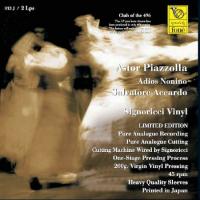Tango Italiano?
The acclaimed violinist Salvatore Accardo commissioned arranger Francesco Fiore to re-imagine his dear friend Astor Piazzolla’s “Adios Nonino,” for, violin, piano and orchestra. Not a bandoneon can be heard on this lush, extraordinarily moving tribute to the great tango composer’s father, whose middle name was “Nonino.”
The powerfully nostalgic piece, written in 1959, has a similar emotional tug on the heartstrings as much of Nino Rota’s Fellini film scores, with fond, almost lighthearted memories giving way to waves of uncontrolled sadness and longing.
Delivered by the Orchestra da Camera Italiana, with Accardo’s violin and arranger Fiore’s viola among the soloists, the playing holds none of the emotion back, as you might expect from an all-Italian production.
The approximately fifty minute work consists of seven, thematically related compositions, one more grand and boldly weepy than the next. The effect is like looking through books of photographs of your youth, or if you’re young, perhaps seeing pictures of your late grandparents who you loved when you were really young, and whom you can barely recollect, save for the feelings.
You can’t listen to this and not be deeply affected, but in a good, never morbid or melodramatic way. The opening piece also called “Adios Nonino,” featuring Laura Manzini’s piano solo begins with reflective sadness, fond remembrances and then, with the introduction of Accardo’s violin and arranger Fiore’s viola, unrequited grief and weeping guaranteed to give you the “willies.” But there’s more to the piece as it delves into feelings of anger, unfairness, despair and helplessness before melting into just plain sadness. The piece resolves with the piano joining the solo string duo and the full orchestra.
Each of the set’s seven pieces offers a different facet of Piazzolla’s grief and remembrance as he mourns and expresses his loss, with the most searingly dramatic and beautiful being “Milongo del Angel.”
The spacious, tonally rich, somewhat distant-sounding recording by foné founder Giulio Cesare Ricci in Rome’s Pontifcio Istituto di Musica Sacra uses minimalist techniques and vintage gear including tube-based Neumann U47, U48 and M49 microphones and a 2 Track Studer C37.
Simply miked recordings often achieve purity and dimensionality at the expense of precise imaging and this recording is no exception, particularly in how Mr. Accardo’s violin suffers from some “image wander,” not surprising, given how the instrument must have moved about as he played. The result is a bit of left/right “flitting about.”
Another issue is the percentage of direct to reflected sound the recording captures. There’s lots of room sound, which gives the presentation a great deal of spaciousness. However, if you play it too loud, the reflected sound tends to dominate, which reduces the clarity of the direct sound causing it to get lost in the reverb, thus distressing accurate instrumental timbres.
The key to getting this to sound right is to not play it too loud, thus producing the appropriate mid-hall balance. Played back that way, the recording, with the exception of the occasional wandering solo image, achieves greatness.
This is an expensive package costing $130 on vinyl but only $20 on Hybrid SACD. Why so expensive? It’s a double 200g 45 rpm Japanese-pressed set, produced at the same factory as the recent highly acclaimed UMG series that quickly sold out of most titles, priced around $40 each.
The difference between those and this is that the engineer, Mr. Ricci, cut the lacquers on his own lathe using the original analog tape played back on the machine used to record it and produced the record using a “one-step” process. For those unfamiliar, record production usually consists of a lacquer cut on a lathe, with the lacquer plated to produce a ridged “father.” While the “father” can be used to press records, it has a limited life before it wears out. When that happens, the only choice to produce more records is to cut yet another lacquer. Rather than doing that, most records are produced by taking the “father” and plating it to produce a “mother” (grooved metal part). The “mother” is then plated again to produce a stamper used to press records. The “mother” can be plated numerous times to produce a multitude of stampers before it too must be retired, and another “mother” produced from the “father.”
In the case of a single-step LP, the “father” itself is used as a stamper for a limited run, in this case being 496 copies. Why 496? It’s the eccentric (but lovable) Mr. Ricci’s favorite and/or lucky number. Ricci is also a winemaker. He limits his yearly output to 496 bottles as well.
So this is a purist recording, a purist lacquer cut, a purist plating and a purist 200g Japanese pressing, with one man doing the audiophile quality recording using cables and microphone preamps of his own design. That’s why it costs what it does. You could always buy the hybrid SACD for $20 to see if you like the music first, but with only 496 copies pressed for world wide consumption, who knows if the vinyl will still be available by the time you’re ready for it. Your choice, but either way, this is a recording and performance worth savoring. It will move you every play.


